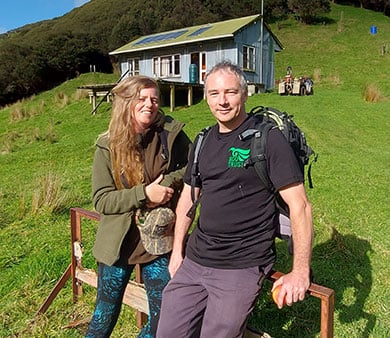Archived content: This media release was accurate on the date of publication.
Date: 04 July 2023
The Eight Hundred Trust – led by trustees and conservationists Miranda Wells, Daryl Egarr and Bjorn Doherty – owns more than 3,800 acres of steep manuka-clad Taranaki landscape where telecommunications connectivity is difficult to obtain and retain.
The trust received funding via Jobs for Nature to undertake predator and weed control and create a biodiversity corridor between Lake Rotokare and Omoana. The project is called “The gateway to the Matemateonga range - Omoana Project - Rotokare to Omoana Biodiversity Corridor”. It has been supported by DOC which allocated the funding on behalf of the Government.

Miranda Wells and Daryl Egarr from The Eight Hundred Trust.
Image: Jeff Neems, DOC
On top of the usual on-the-ground conservation methods such as planting and numerous models of pest traps – and salaries for father and son team Ian and Koby Gavin, doing much of the day-to-day work – the Jobs for Nature funding has supercharged the trust’s data-driven approach to controlling predators.
Daryl and Bjorn have professional backgrounds in IT, and their skills have been vital to developing wifi connectivity and repeater stations across the expansive property.
More than 40 cameras monitor areas of the extensive rugged landscape, with images captured transmitted via several wifi repeaters dotted across ridge tops and hillsides. The images from the cameras are monitored by object recognition software written in-house, and determine where traps need to be moved to to control pests such as mustelids, feral cats and possums.
An example of the effectiveness of the system involved a feral cat. The predator was picked up by a camera monitoring the decking on the property’s hut, image recognition detected the object was a cat and alerted staff, and the cat was captured within hours by a repositioned trap. Daryl says in a remarkably similar set of circumstances, the same method worked with a stoat – picked up on a camera and trapped in the same spot a week later.
The trust’s use of technology isn’t limited to cameras and wifi guiding predator control efforts. They’re currently working on an advanced telemetry product, an acoustic recorder to detect and log the calls of native birds and bats more specifically than many current similar tools, allowing for more distinct identification of the sounds of particular native species.
Daryl says the digital telemetry tool the trust will potentially supercede human bird call counters, whose expertise is built up over hundreds of hours of field work understanding and identifying the sounds different native birds make.
And although humans will still be needed to install the telemetry devices, the trust’s intention is to have a technological tool that can carry out the work of a group of people – and deliver the information digitally to a central IT storage location.
By deploying the telemetry bird recorder, they will have access to “all of the data, all of the time,” says Daryl – rather than just when human bird call counters are available and conditions suit.
“Bird call work is hard,” says Daryl. “It takes a lot of skill and experience to learn all the bird calls, and a lot of concentration for the duration of the call period.
“Add to that the time and cost to have multiple people travelling to a remote area to carry out simultaneous bird call logging, and you can easily see why the resulting data is sparse.
“And on top of that, you have the variablity of the hearing capacity of the person recording rhe calls, so comparisons across sites or across time can be significantly influenced by the person doing the work.”
With the trust’s device, information from the recorders is relayed instantly and the recorder is listening 24/7.
Bjorn is currently refining the code for the programme, and working on the hardware.
“There’s a lot of testing to be done,” Daryl says. “But the approach has been proven, and the chips we are running on are proving to be very capable of the processing required.”
“We’re hoping that in a year’s time, we’ll have a telemetry product the public and community can use,” Miranda says.
Miranda says the trust’s development of IT isn’t a profit-driven exercise, “and fundamentally, any money we make will go back into conservation”.
They’ve created a trust charity which will see any earnings reinvested into conservation.
“We’re trying to be self-sustainable after Jobs for Nature, and this is our pathway to get there.”
Background information
The Government’s Jobs for Nature programme is a $1.219 billion COVID-19 recovery investment which aims to benefit New Zealand’s environment, people, and regional communities.
As a part of this programme DOC will allocate $485 million to projects that will create nature-based job opportunities for approximately 4,800 people over a four-year period.
It is supercharging the conservation efforts of DOC, iwi and hapū, councils, and the wider community to implement kaitiakitanga. This funding will help restore the mauri and mana of Te Taiao (our nature) by controlling pests and weeds, restoring wetlands, and returning native bush, rivers, and streams to health.
Contact
For media enquiries contact:
Email: media@doc.govt.nz
